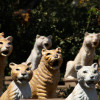
Across the world and throughout history, animals have held a crucial position in the tapestry of human culture. They appear in our earliest cave paintings, influence the designs of our gods and monsters, and feature prominently in our stories and myths. These animals, real and mythical, are part of our shared human experience, bringing with them lessons, morals, and understanding about our world and ourselves. In this article, we delve into the spellbinding realm of animals in folklore and mythology.
The Symbolic Significance of Animals in Mythology
Animals in mythology are often used as symbols or allegories, embodying certain human characteristics or qualities. For instance, in many cultures, the lion, with its strength and courage, represents authority and power. The cunning fox is frequently associated with craftiness and trickery, while the turtle, which carries its home on its back, serves as a symbol of patience and perseverance.
The Role of Animals in Mythological Stories
Animals play vital roles in many mythological stories. In some instances, they serve as faithful companions or helpers to the heroes; in others, they can be challenges or obstacles that the heroes must overcome. Some animals are deified and worshipped, possessing sacred and mystical attributes. They may also be etiological, explaining natural phenomena. An excellent example of this is the Australian Aboriginal Dreamtime story of Tiddalik the Frog, who drank all the water in the world and released it after being made to laugh, thus explaining droughts.
Animals and Their Characteristics in Different Cultures
The interpretation of animals and their characteristics differs across cultures. For instance, in Celtic mythology, the salmon is considered a symbol of wisdom and knowledge, while in Native American lore, the bear is a symbol of strength and courage. In Greek mythology, the owl is associated with Athena, the goddess of wisdom, and is seen as a harbinger of good fortune. In contrast, in some African mythologies, the hyena, due to its scavenging nature, is often considered a symbol of treachery and deceit.
Animals in Folklore
Like mythology, folklore is rich in references to animals. Folklore is the traditional oral transmission of customs, tales, and beliefs of a culture. The tales often involve animals with human characteristics and usually convey a moral or societal lesson. For example, the Aesop's Fables from ancient Greece, which include 'The Tortoise and the Hare' and 'The Boy Who Cried Wolf', are centuries-old folklore stories featuring anthropomorphized animals that teach moral lessons.
Mythical Creatures: The Blend of Human and Animal
Some of the most captivating aspects of mythology and folklore are the mythical creatures that are hybridizations of humans and animals. These include Sphinx from Greek mythology, half woman and half lion, and Minotaur, half man and half bull. Such creatures often symbolize the blending of human intelligence with the raw power and instinct of animals. They serve as intriguing embodiments of the complexities of the human psyche and are reminders of our intrinsic connection with nature.
















